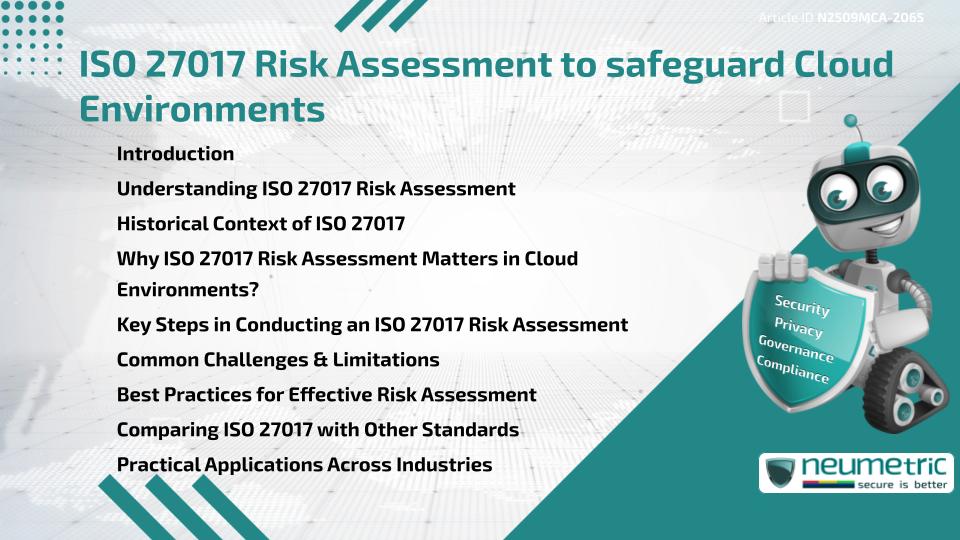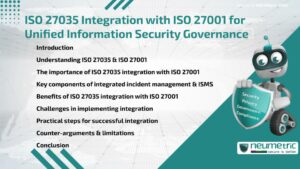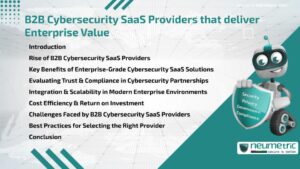Table of Contents
ToggleIntroduction
ISO 27017 Risk Assessment is a structured approach designed to identify, evaluate & mitigate security Risks within cloud environments. It is based on the international Standard ISO/IEC 27017, which provides additional cloud-specific controls on top of ISO/IEC 27002. By performing an ISO 27017 Risk Assessment, Organisations can ensure better protection of Sensitive Data, maintain Regulatory Compliance & establish trust with customers. This Assessment helps detect Vulnerabilities, strengthen Governance & improve resilience against Threats such as data breaches, misconfigurations & unauthorised access.
Understanding ISO 27017 Risk Assessment
An ISO 27017 Risk Assessment focuses specifically on cloud services, addressing shared responsibilities between cloud service providers & cloud users. Unlike general Information Security frameworks, it emphasizes controls unique to cloud environments such as virtual machine configuration, shared tenancy & secure data deletion. The process provides clarity on accountability & ensures that Risks are handled appropriately.
For Organisations adopting cloud, an ISO 27017 Risk Assessment acts as a bridge between general Information Security practices & the specialized demands of cloud computing. It not only identifies Risks but also provides actionable insights for securing applications, infrastructure & data stored in the cloud.
Historical Context of ISO 27017
ISO/IEC 27017 was published in 2015 as a code of practice for Cloud Security. It evolved from ISO/IEC 27002 but included new guidance tailored to cloud services. The Standard was created in response to the rising adoption of cloud technology, which brought unique Risks not covered adequately by existing security standards. Since then, ISO 27017 Risk Assessment has become an integral part of cloud Governance, ensuring that both providers & users uphold strong security practices.
Why ISO 27017 Risk Assessment Matters in Cloud Environments?
Cloud environments are dynamic, scalable & widely distributed, which makes them both efficient & vulnerable. Without an ISO 27017 Risk Assessment, Organisations Risk overlooking key Vulnerabilities such as:
- Insecure access management
- Data storage in multiple jurisdictions
- Insufficient encryption practices
- Poor separation of duties between providers & users
By implementing an ISO 27017 Risk Assessment, Organisations can identify such Risks early & implement targeted controls. This helps maintain compliance with laws such as GDPR & HIPAA while fostering Customer Trust.
Key Steps in Conducting an ISO 27017 Risk Assessment
Conducting an effective ISO 27017 Risk Assessment involves a systematic approach:
- Define the scope – Identify which cloud services, data & operations are included.
- Identify Threats & Vulnerabilities – Consider both internal & external Risks such as insider Threats, system flaws or Third Party dependencies.
- Evaluate Risks – Assess the Likelihood & Impact of each identified Risk.
- Select controls – Map Risks to relevant ISO 27017 controls & implement mitigation measures.
- Document & monitor – Maintain Evidence of the Assessment & regularly review updates as cloud environments evolve.
This process ensures that Risks are addressed in a structured & auditable manner.
Common Challenges & Limitations
While ISO 27017 Risk Assessment provides strong guidance, Organisations may face challenges such as:
- Misunderstanding shared responsibilities between providers & clients
- Difficulty in monitoring Risks across multi-cloud environments
- Limited resources for Continuous Monitoring & Assessment
- Overreliance on provider assurances without independent verification
These limitations highlight the importance of combining ISO 27017 with other standards, Continuous Training & independent audits.
Best Practices for Effective Risk Assessment
Organisations can enhance the effectiveness of an ISO 27017 Risk Assessment by:
- Establishing clear roles & responsibilities with providers
- Automating monitoring & logging for continuous visibility
- Regularly reviewing controls to adapt to changes in technology & regulations
- Integrating Risk Assessment into business decision-making processes
Such practices not only safeguard information but also ensure that security investments align with organizational goals.
Comparing ISO 27017 with Other Standards
ISO 27017 is often compared with ISO 27001, NIST Cybersecurity Framework & CSA Cloud Controls Matrix. While ISO 27001 covers broader Information Security management, ISO 27017 focuses specifically on cloud environments. NIST offers detailed technical controls, whereas ISO 27017 emphasizes Governance & accountability. Together, these frameworks complement each other, providing a comprehensive security strategy.
Practical Applications Across Industries
ISO 27017 Risk Assessment is applicable across industries that rely on cloud computing, including Finance, Healthcare, retail & education. For example, Financial institutions use it to manage Risks related to online banking, while Healthcare Organisations rely on it to secure Patient Data stored in cloud-based electronic health records. In each case, the Assessment provides assurance that Sensitive Information is protected under a recognized global standard.
Conclusion
ISO 27017 Risk Assessment is an essential tool for Organisations adopting cloud environments. It helps identify Risks, implement effective controls & establish accountability between providers & users. By aligning with this standard, businesses can strengthen security, meet Compliance Requirements & build trust with Stakeholders.
Takeaways
- ISO 27017 Risk Assessment provides cloud-specific guidance for Risk Management.
- It emphasizes shared responsibilities between providers & clients.
- Conducting the Assessment systematically ensures comprehensive coverage.
- Challenges can be mitigated with Best Practices & complementary standards.
- It is relevant across industries that depend on cloud technology.
FAQ
What is ISO 27017 Risk Assessment?
It is a structured process based on ISO/IEC 27017 that identifies & mitigates Risks specific to cloud environments.
How does ISO 27017 Risk Assessment differ from ISO 27001?
ISO 27001 covers general Information Security management, while ISO 27017 focuses on cloud-specific Risks & controls.
Who should conduct an ISO 27017 Risk Assessment?
Both cloud service providers & cloud customers should conduct assessments to ensure shared responsibility is addressed.
How often should ISO 27017 Risk Assessment be performed?
It should be carried out regularly, especially after major changes in cloud infrastructure or services.
What are the benefits of ISO 27017 Risk Assessment?
It strengthens security, ensures compliance, improves Governance & enhances Customer Trust.
Does ISO 27017 Risk Assessment apply to multi-cloud environments?
Yes, it provides guidance that can be adapted to hybrid & multi-cloud strategies, though monitoring may be more complex.
Is ISO 27017 mandatory for cloud providers?
It is not legally mandatory but is widely recognised as a best practice & may be required by clients or regulators.
Need help for Security, Privacy, Governance & VAPT?
Neumetric provides organisations the necessary help to achieve their Cybersecurity, Compliance, Governance, Privacy, Certifications & Pentesting needs.
Organisations & Businesses, specifically those which provide SaaS & AI Solutions in the Fintech, BFSI & other regulated sectors, usually need a Cybersecurity Partner for meeting & maintaining the ongoing Security & Privacy needs & requirements of their Enterprise Clients & Privacy conscious Customers.
SOC 2, ISO 27001, ISO 42001, NIST, HIPAA, HECVAT, EU GDPR are some of the Frameworks that are served by Fusion – a SaaS, multimodular, multitenant, centralised, automated, Cybersecurity & Compliance Management system.
Neumetric also provides Expert Services for technical security which covers VAPT for Web Applications, APIs, iOS & Android Mobile Apps, Security Testing for AWS & other Cloud Environments & Cloud Infrastructure & other similar scopes. Reach out to us by Email or filling out the Contact Form…





